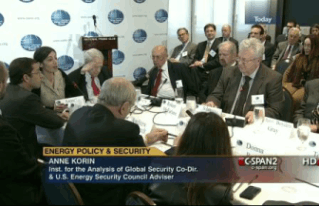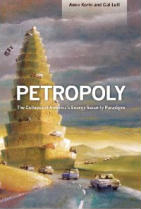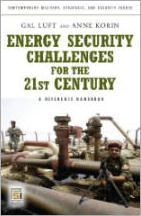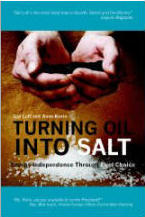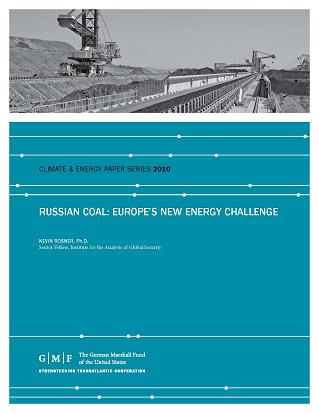Bridging a robust national security policy in meeting vulnerabilities associated with power supply (electricity) and fuels (primarily used in transportation) is an emergent 21st century security challenge for all nations. The potential individual single points of failure where fuels and power (hereafter energy) are concerned are compounded for countries which lack adequate domestic resources necessary for one or both of these end uses. Geology being what it is, nations cannot create natural reserves of oil, gas, coal, and water to power their economies and provide for their citizens. What they can do however is to put in place policy frameworks that address energy vulnerabilities for bolstering the state’s national security. These policies include domestic regulatory and investment policies, foreign policy, and national security policy. Policy choices where energy is concerned have traditionally been thought of as primarily a mix of market-based responses to meet a nation’s energy requirements; however market mechanisms alone have shown signs of weakness in correcting for producer nations which have increasingly used their energy resources to attempt to exact political concessions from energy consumers or as producers have either intentionally limited output or unintentionally failed to meet the soaring growth in energy demand particularly from the world’s emerging economies. The reality is that energy has moved far beyond an exclusive resource issue into the realm of new emerging threats and challenges to national security and global stability.
Energy and national security
For military forces, the priority energy concern is to have sufficient energy to support current operations and to support a national security strategy that addresses the country’s national interests. For government writ large, the objective is more broadly defined and of a greater order of magnitude: to have sufficient energy to sustain current operations among them economic activity, the delivery of health and human services, to sustain food, water, and communications networks, and heating and cooling generation and distribution systems which are essential to human development. To be sure military forces’ and government’s interests where energy is concerned should be complimentary and mutually supporting. This has not always been the case. There is on the other hand a sea-change in attitude in some nations for bridging the gap between energy and national security policy, and in the case of the US military, leadership is stepping up to the plate to close this gap. In doing so the US armed forces are helping to pioneer the introduction of new technologies, fuels, programs, research and development and even behaviors that address the multiple dilemmas confronting the armed forces in meeting their operational energy needs and in doing so in bolstering national security.
The primary mission of the state, with the military being only one among other tools within a nation’s arsenal, is to protect state sovereignty and security through the exercise of a range of policy options and mechanisms in this case, where energy is concerned. In short the military-energy nexus can be seen as a sub-set of national security policy. Strangely enough sometimes the efforts of the state itself to bridge the gap between energy and national security do not help but hinder the bolstering of national security and in doing so defeat the priority mission they are responsible for.
The military angle
Operational energy is the key phrase that defines the US Department of Defense’s concept and doctrine towards how the military uses energy in its military operations. These include operations abroad as in Afghanistan and Iraq and at military installations at home and around the world. The DoD’s operational energy strategy states that, “The Department’s top mission priority today is to support current operations, and DoD Components should focus their operational energy investments accordingly. The Department also has a duty to ensure the future security of the Nation, making planning and force development an important operational energy focus, as well. The Department has an interest in long-term national energy security and should take steps to work with other Federal agencies and the private sector to diversify and secure fuel supplies. Finally, operational energy is an important tool for strengthening U.S. Alliances and partnerships with other nations, a key strategic goal for the Nation.” This strategy is rich in both substance and vision and is worthy of some, however brief, elaboration. First, the US Department of Defense is the single largest consumer of oil in the US government consuming over five billion gallons of fuel in US military operations and training in 2010. There is therefore a real cost associated with fueling US armed forces paid for by the taxpayer and borne by the military in heavy military planning, logistics and support operations to get fuel to the soldier. When failure occurs in these operations it is measured at a minimum by the killed and wounded in moving fuel around and into the field. In fiscal year 2007 in Iraq and Afghanistan, a total of more than 3,000 Army personnel and contractors were wounded or killed in action from attacks on fuel and water resupply convoys.
This strategy is to make forces more effective and efficient by lowering risks to warfighters, to be able to shift resources to other warfighting priorities and to save money for American taxpayers as outlined by the Deputy Secretary of Defense in May 2011. The DoD strategy outlines three ways of accomplishing these objectives: by reducing the demand for energy in military operations, by expanding and securing the supply of energy to military operations, and by building energy security in the future force.
Other nations, such as the United Kingdom, are looking at ways to improve their operational use of energy. As Andrew Chutter wrote for Defense News in July of this year, “The combination of rising oil prices, declining defense budgets, poor miles per gallon, reduction of emissions and the longer-term security of supply has the U.K. military starting to think green.” However, ‘going green’ is one thing while bridging the gap between energy and national security is another. While reducing a military force’s carbon footprint may be exemplary doing so should not come at the cost of reducing the warfighter’s effectiveness or in reducing the resiliency and sustainability of base operations supporting the solider.
One program presently being explored by military contractors in the US could conceivably achieve the objectives of making military bases more resilient and also reduce carbon dioxide emissions. This program involves exploring ways of providing off-grid renewable power generation at competitive prices while at the same time ensuring energy reliability in the event of natural disasters or terrorist and cyber –attacks. Army Secretary John McHugh formed the so-called “Energy Initiatives Task Force” as a one-stop shop for the development of cost-effective large-scale Army renewable energy projects. Again the objective being to reduce the military’s energy burden, reduce base operating costs, while increasing the surety of supply by introducing decentralized generation and distribution of power through micro-grids. Proponents of the program argue that excess energy generated beyond meeting military requirements could be sold back to community’s hosting military installations. There are of course hundreds if not thousands of other proposals on the table to address operational energy, including lighter materials in military hardware to smaller and lighter batteries used by soldiers in the field. However, armed forces around the world cannot and should not count on the US military alone for pioneering operational energy research, development, and deployment.
The real prize:NATO
Returning to the DoD’s description of operational energy, it is also “an important tool for strengthening U.S. Alliances and partnerships with other nations, a key strategic goal for the Nation.” Here the Trans-Atlantic Alliance, NATO, needs to be brought into the discussion. First, an assessment needs to be carried out to fully understand and appreciate the role of oil in Alliance operations. Putting into perspective the financial cost of oil use and delivery within an Alliance context, aside from the human cost, would underscore the heavy burden NATO members are paying for this dependency. Secondly, the delivered, let alone the fully burdened cost of fuels, is at best poorly understood if understood at all within an overall Alliance framework. This needs to be addressed. Such a baseline assessment would help gain an appreciation for the real value in achieving more fight with less fuel and in doing so in getting a real handle on understanding the Alliance’s demand for operational energy.
The next step should examine, modeled on the US Operational Energy Strategy, and identify the low hanging fruit where an improvement in the efficiency of military use of energy would be immediately most cost-effective in enhancing military effectiveness. The near term benefits of such an assessment should lead to a reduction in NATO military operational risks and costs. Second, such as assessment would avoid the thorny issues of talking about all energy commodities, particularly natural gas that is a politically charged issue among NATO members particularly where Russia is concerned. Third, given the assessment’s focus on improving the effectiveness of military performance is at the heart of NATO’s role as a collective security organization. Fourth, in improving effectiveness there is a heavy focus on increasing efficiencies in military operations which is politically and fiscally palatable to all nations. Finally, as military organizations look to multiple solutions for fuel and power alternatives they are already examining a broad range of innovative options ranging from testing biofuels in operational aircraft, deploying off-grid renewable energy generation for fixed and mobile operating bases, waste-to-fuel alternatives in naval vessels, and the application of a variety of energy saving technologies for the warfighter on the ground. For some NATO members renewable energy is of particular interest as it reflects a nation’s public consensus in lowering GHG emissions in this case by ‘greening’ the military. This leads to the economies of scale argument whereby instead of 27 NATO member nations pursuing similar, and often duplicative, research and development efforts in improving operational energy a more coordinated and collective response to doing more with less is relevant. In short, a concerted and focused NATO approach towards an operational energy strategy would provide a fundamental basis for future interoperability of selected optimal new technologies that meet the nations’ requirements for the warfighter in the future.
Government responsibility for bridging the energy-national security gap
Power generation, transmission and distribution networks have undergone significant change over the past two decades. Aside from technological advancements and an increase in power generating efficiencies it is the ownership structure of energy assets that has undergone the most fundamental change in many corners of the world. In many countries, ownership of energy assets remains with national governments whereas large scale privatization in power has occurred throughout much of the developed world. It is on this point that there is a disconnect between energy and national security because the regulatory policies governing the provision of power have in large part not kept pace with the privatization process and have lacked a national security perspective. Privately held electricity giants seek profit maximization for their shareholders but in doing so often lag in providing redundancy capacity, spare parts, in some cases necessary maintenance and investment in future power generating, transmission and distribution capacity. The European Union, the largest competitive market for electricity and gas in the world, has sought to correct this by passing significant legislation such as Directive 2005-89-EC with a view to insuring the functioning of the internal energy market through obligations to safeguard security of electricity supply and undertake significant investment in electricity networks. While these steps are laudable and necessary, the security of supply especially for natural gas suffered two major setbacks since 2006 as a result of Russia’s gas disputes with the Ukraine its most important transit state. Further, European gas dependence on Russian exports is increasing with policy implications far beyond energy itself.
What to do?
Energy and national security go hand in hand. Clearly energy is only one aspect of national security but it is an important one. Regardless of the ownership structure of any given country’s energy assets, it is incumbent on government to devise and adhere to a policy that bolster’s energy and national security at every link in the energy supply chain. In planning for emergency contingencies and in considering the cost and value of new infrastructure, for example that leads to diversification in both power and commodity supplies, national security considerations should weigh heavily in what otherwise might be considered a private sector initiative. Business can build it, business can manage it, but government needs to regulate it to ensure it meets national security requirements. If short term commercial benefits of let’s say, a gas interconnector, fall short of commercial expectations but meets a critical national security need then government should ante-up and burden the cost of this piece of infrastructure’s contribution to the nation’s security. Take for example, the effects of the 2009 Russian gas cut-off on the Slovak Republic. Slovakia plays an important role in delivering Russian gas to its downstream Western European partners. Because of its vital link in East-West gas delivery, the country could not imagine that Russia would take actions that would disrupt the flow of this strategic commodity to the country. But that is precisely what occurred. According to Andrej Nosko and Peter Sevce, “After failing to secure its own energy supply (and especially natural gas) for years, Slovakia was one of the worst hit countries in Europe during the 2009 Russia-Ukraine gas crisis. According to some sources, Slovakia lost 100 million Euros a day, or 1 billion Euros over the duration of the entire crisis, and the gas-cut related recession led to a 1-1.5% decrease in GDP. National tax revenue to the Slovak government in January 2009 dropped by 40% (due to both the gas crisis and the recession). Some Slovak companies, as part of their own contingency plans, which were to be invoked in the event of an energy crisis, even began to prepare to relocate parts of their production elsewhere. Some companies chose not to disclose an exact quantification of their losses (not even to the Ministry of Economy), so the real extent of the impact remains unknown. This is a real wake-up call of what happens when energy security is taken for granted.” Thinking the unthinkable is what national security is all about and had Slovakia’s leadership prepared for such a contingency, and invested in mitigating the effects of what became an eventuality, the financial and human cost to the Slovak Republic could have been lessened. To put this in some perspective, according to the US government the relative cost of responding to the devastation wrought by US hurricane Katrina versus the preventative cost of adequately preparing for this Category 5 storm was 15 to 1. In short, human lives, property destruction, and the general instabilities that ensued in the wake of this natural disaster could either have been altogether avoided in some cases, or at a minimum mitigated, had some serious advanced thinking and investment gone into making the Gulf Coast more resilient to the effects of the storm. Where energy and national security are concerned serious advanced analyses needs to become part of institutionalized thinking which considers the potential costs of the status quo as opposed to the real, but potentially lesser costs of preparing for energy related national security challenges
Similarly in a recent article by Jamie Shea, NATO Deputy Assistant Secretary General for Emerging Security Challenges, he suggests that NATO requires a radical change in institutional thinking and culture if it is going to address the emerging threats in the 21st century to Alliance peace and stability. He writes that, “NATO has to enhance the resilience and recovery capacity of its member states rather than to seek absolute prevention.” Shea is absolutely correct and his observations are relevant not only for NATO but for all its member states in their efforts in addressing the gap between energy and security both as sovereign states and as members of the Alliance.
The litmus test for national security where energy is concerned is whether a given project or policy actually bolsters diversification in a nation’s energy mix, country of supply, or in energy transit. The recent unveiling of the Nord Stream Baltic pipeline from Russia to Germany is instructive as it fails on all three counts. First, Germany is becoming more not less dependent on natural gas which does nothing for the country’s energy mix. In fact, in light of Germany’s parallel decision to shut down its nuclear industry the mix is likely to become less diversified over the short term until their renewable energy aspirations are met. Second the pipeline intensifies rather than diversifies the volume of gas coming from Russia so it fails on this basis to meet the energy-security diversification standard. Third, while the pipeline does offer a new transit network for Russian gas delivery, Nord Stream is controlled by Gazprom’s 51% ownership stake so real diversification here is nuanced by Russian majority ownership of the infrastructure itself.
When fuel and power mix are concerned, national policies to address climate issues are not symbiotic with steps to close the energy-security gap. Doing away with coal fired power generation may reduce GHG emissions, but given the fact that coal makes up the largest percentage of the world’s primary energy mix for base load power generation drastic steps to transition to other fuels may impact negatively on the energy-national security nexus. In the post Fukushima era, abandoning nuclear power may be politically palatable but if it weakens a nation’s power mix national security implications should be considered. On the other hand expanding nuclear power carries with it potential proliferation issues as well which must be considered when it comes to national or in this case international security. Decentralized power generation, particularly from renewables, can help bridge the gap between energy and national security while concurrently helping to achieve climate change objectives but they need to be transitioned in as renewables, even if maximized in terms of deployed generating assets, still provide intermittent power that has to piggy-back on 24/7 base load generation from conventional fuels.
Finally, national governments, not the military, are accountable for a nation’s foreign policy and diplomatic relations with other states. While technology is opening up markets and the supply chain for conventional and unconventional gas and transit, LNG and shale gas are two examples, oil is a different story. Rocketing demand for oil and refined petroleum products used in transportation, declining reserve to production ratios for producers and the cartelization of global oil production that limits supply are all aspects of the consumer-producer dialogue. This imbalanced dialogue is disadvantageous for consumers allowing producers to use oil to influence consumers’ policy choices in domains far afield from energy itself. To reiterate, while there are geological limitations to energy resources policy choices abound in shoring up the growing gap between energy and national security. While these policy choices may be long term in scope, for example in transitioning away from overt dependence on oil-derived fuels, steps need to be taken now to catalyze this transition. The same can be said in transitioning towards a greater share of renewables in the power mix despite its limitations.
In conclusion, an operational energy revolution for military organizations is in the offing with the result that armed forces use of fuel can both save lives, improve the effectiveness of the warfighter, and more closely mirror challenges and volatility in global energy markets. In the 1960s in the United States, DoD and NASA R&D often led to introduction of new technologies and materials that transformed the US economy. Further as the armed forces are often considered a conservative muscle of government, if they can catalyze increased efficiencies and more deployable renewable power in a drive for more bang for the buck this sends a strong message to society as a whole that closing the gap between energy and national security is doable. It is also incumbent on government to closely scrutinize policies across the board that have implications for national security with an eye towards energy which requires new institutionalized integrated decision making. Where energy and climate are taken together in the same breath, the choices are not always clear. Depending on where one sits, national security where energy is concerned may take precedence over climate and vice-versa. These policies and interests are not in an immediate sense necessarily symbiotic but the aspiration is that over the long term they become mutually complimentary.
Contributor Kevin Rosner is a Senior Fellow with the Institute for the Analysis of Global Security and Editor of the Journal of Energy Security.



 Archive
Archive 



